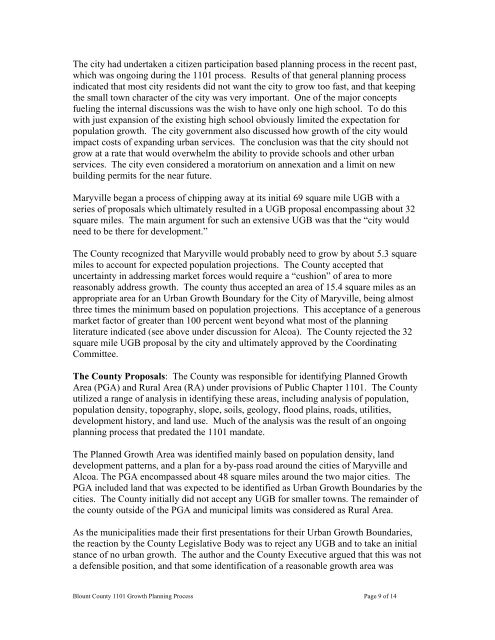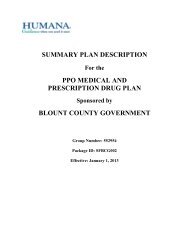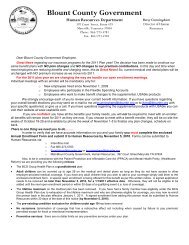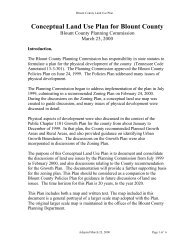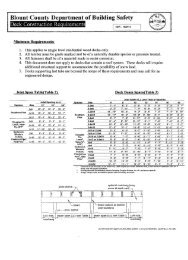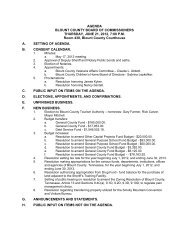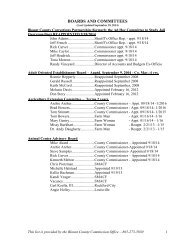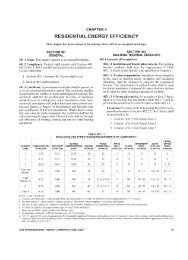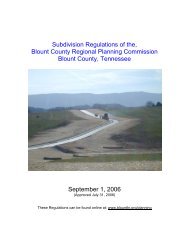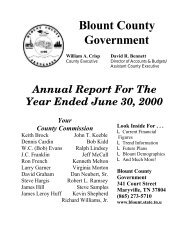Reflections on the 1101 Process in Blount County, Tennessee
Reflections on the 1101 Process in Blount County, Tennessee
Reflections on the 1101 Process in Blount County, Tennessee
Create successful ePaper yourself
Turn your PDF publications into a flip-book with our unique Google optimized e-Paper software.
The city had undertaken a citizen participati<strong>on</strong> based plann<strong>in</strong>g process <strong>in</strong> <strong>the</strong> recent past,which was <strong>on</strong>go<strong>in</strong>g dur<strong>in</strong>g <strong>the</strong> <strong>1101</strong> process. Results of that general plann<strong>in</strong>g process<strong>in</strong>dicated that most city residents did not want <strong>the</strong> city to grow too fast, and that keep<strong>in</strong>g<strong>the</strong> small town character of <strong>the</strong> city was very important. One of <strong>the</strong> major c<strong>on</strong>ceptsfuel<strong>in</strong>g <strong>the</strong> <strong>in</strong>ternal discussi<strong>on</strong>s was <strong>the</strong> wish to have <strong>on</strong>ly <strong>on</strong>e high school. To do thiswith just expansi<strong>on</strong> of <strong>the</strong> exist<strong>in</strong>g high school obviously limited <strong>the</strong> expectati<strong>on</strong> forpopulati<strong>on</strong> growth. The city government also discussed how growth of <strong>the</strong> city wouldimpact costs of expand<strong>in</strong>g urban services. The c<strong>on</strong>clusi<strong>on</strong> was that <strong>the</strong> city should notgrow at a rate that would overwhelm <strong>the</strong> ability to provide schools and o<strong>the</strong>r urbanservices. The city even c<strong>on</strong>sidered a moratorium <strong>on</strong> annexati<strong>on</strong> and a limit <strong>on</strong> newbuild<strong>in</strong>g permits for <strong>the</strong> near future.Maryville began a process of chipp<strong>in</strong>g away at its <strong>in</strong>itial 69 square mile UGB with aseries of proposals which ultimately resulted <strong>in</strong> a UGB proposal encompass<strong>in</strong>g about 32square miles. The ma<strong>in</strong> argument for such an extensive UGB was that <strong>the</strong> “city wouldneed to be <strong>the</strong>re for development.”The <strong>County</strong> recognized that Maryville would probably need to grow by about 5.3 squaremiles to account for expected populati<strong>on</strong> projecti<strong>on</strong>s. The <strong>County</strong> accepted thatuncerta<strong>in</strong>ty <strong>in</strong> address<strong>in</strong>g market forces would require a “cushi<strong>on</strong>” of area to morereas<strong>on</strong>ably address growth. The county thus accepted an area of 15.4 square miles as anappropriate area for an Urban Growth Boundary for <strong>the</strong> City of Maryville, be<strong>in</strong>g almostthree times <strong>the</strong> m<strong>in</strong>imum based <strong>on</strong> populati<strong>on</strong> projecti<strong>on</strong>s. This acceptance of a generousmarket factor of greater than 100 percent went bey<strong>on</strong>d what most of <strong>the</strong> plann<strong>in</strong>gliterature <strong>in</strong>dicated (see above under discussi<strong>on</strong> for Alcoa). The <strong>County</strong> rejected <strong>the</strong> 32square mile UGB proposal by <strong>the</strong> city and ultimately approved by <strong>the</strong> Coord<strong>in</strong>at<strong>in</strong>gCommittee.The <strong>County</strong> Proposals: The <strong>County</strong> was resp<strong>on</strong>sible for identify<strong>in</strong>g Planned GrowthArea (PGA) and Rural Area (RA) under provisi<strong>on</strong>s of Public Chapter <strong>1101</strong>. The <strong>County</strong>utilized a range of analysis <strong>in</strong> identify<strong>in</strong>g <strong>the</strong>se areas, <strong>in</strong>clud<strong>in</strong>g analysis of populati<strong>on</strong>,populati<strong>on</strong> density, topography, slope, soils, geology, flood pla<strong>in</strong>s, roads, utilities,development history, and land use. Much of <strong>the</strong> analysis was <strong>the</strong> result of an <strong>on</strong>go<strong>in</strong>gplann<strong>in</strong>g process that predated <strong>the</strong> <strong>1101</strong> mandate.The Planned Growth Area was identified ma<strong>in</strong>ly based <strong>on</strong> populati<strong>on</strong> density, landdevelopment patterns, and a plan for a by-pass road around <strong>the</strong> cities of Maryville andAlcoa. The PGA encompassed about 48 square miles around <strong>the</strong> two major cities. ThePGA <strong>in</strong>cluded land that was expected to be identified as Urban Growth Boundaries by <strong>the</strong>cities. The <strong>County</strong> <strong>in</strong>itially did not accept any UGB for smaller towns. The rema<strong>in</strong>der of<strong>the</strong> county outside of <strong>the</strong> PGA and municipal limits was c<strong>on</strong>sidered as Rural Area.As <strong>the</strong> municipalities made <strong>the</strong>ir first presentati<strong>on</strong>s for <strong>the</strong>ir Urban Growth Boundaries,<strong>the</strong> reacti<strong>on</strong> by <strong>the</strong> <strong>County</strong> Legislative Body was to reject any UGB and to take an <strong>in</strong>itialstance of no urban growth. The author and <strong>the</strong> <strong>County</strong> Executive argued that this was nota defensible positi<strong>on</strong>, and that some identificati<strong>on</strong> of a reas<strong>on</strong>able growth area was<strong>Blount</strong> <strong>County</strong> <strong>1101</strong> Growth Plann<strong>in</strong>g <strong>Process</strong> Page 9 of 14


